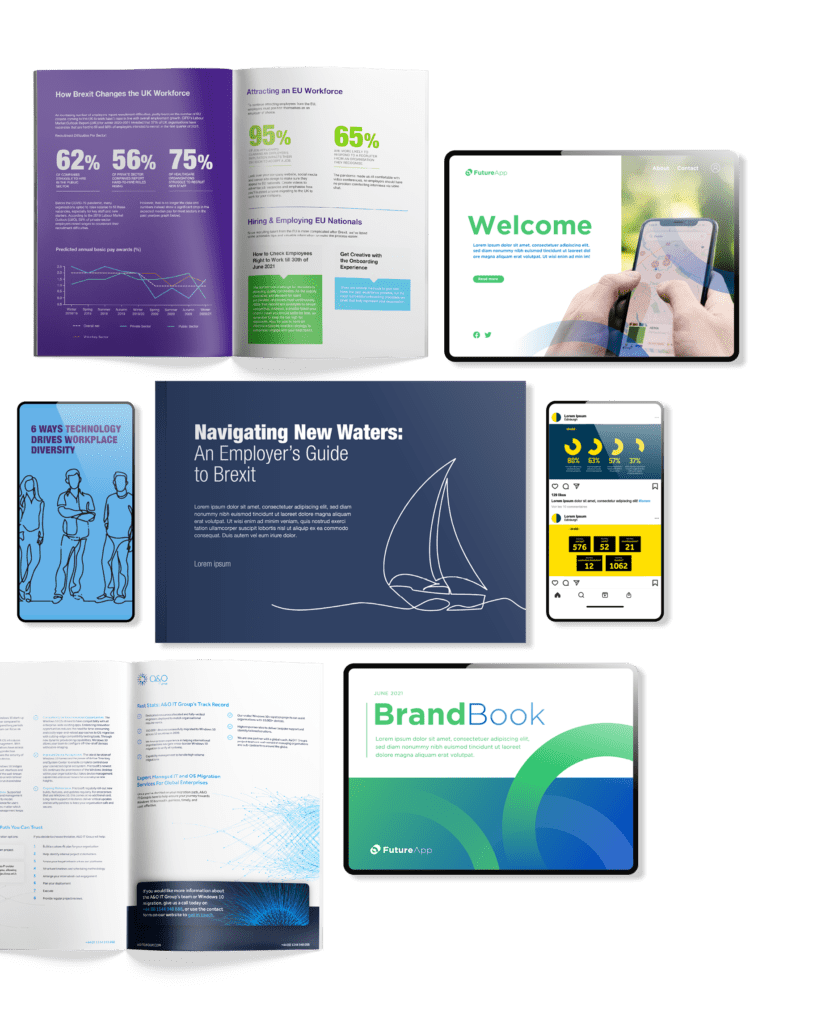Did you know, the human brain processes visual content 60,000 times faster than text?
That’s why it’s extremely important to ensure your content looks visually appealing and is supported by great copy. This will help entice readers, improve engagement and increase leads.
Last week, Managing Director of Copy House, Kathryn Strachan, joined Managing Director of The Content Marketing Association, Rob John, to discuss finding the perfect balance between copy and design. They also looked at how to create content that will drive customers to you instead of your competition. Watch the webinar now, or read on to see all the highlights from Kathryn’s talk.

What is Content Design?
“Content design is the marriage of written content and visual elements to effectively communicate and engage with your audience.’
Kathryn Strachan, Managing Director of Copy House.
Content design is more than just structuring your content to make it look pretty. It requires much more thought and a healthy balance between written content and visual assets.
Most businesses separate their content and design and have them working in separate teams. Although this is a typical approach to content design, this often causes problems due to the lack of communication between design and copy.
The content creator needs to know how to structure the copy, and the copywriter must write with the design in mind. Failing to do this can lead to the final content piece looking out of place or confusing for the reader. This can have a detrimental effect on your brand and the messages your content aims to discuss.
There are numerous examples where both design and copy must be harmonised to create compelling content. These can include:
- Infographics
- Data Visualisation
- Whitepapers
- eBooks
- Social Media Posts
The Importance of Content Design in Marketing
“Content design allows your audience to better understand and interact with your content.”
Kathryn Strachan, Managing Director of Copy House.
Design plays an integral role when attracting visitors to your website. On average, a web user has an attention span of 6.8 seconds when viewing a page. This can be increased by 50 milliseconds if the page is visually appealing and user friendly.
With that in mind, 94% of consumers leave a website if it’s poorly designed. The most common reasons for high exit rates due to poor design include:
- The reader feels overwhelmed by the high volume of text.
- The reader has little patience for content and wants more accessible information.
- The website lacks credibility. A website user is unlikely to purchase a product if they don’t trust the site.
For these reasons, 80% of SMB’s consider design an important factor in their companies’ success. That’s why it comes as a shock that only 51% of B2B digital marketers value visual assets in content marketing. Kathryn believes that this statistic is low because they fail to realise the positive impact content design can have on the B2B market.
Positive Impact of Content Design
By incorporating content design into your marketing strategy and having it support your copy, your content can excel dramatically. Here are just a few ways it can improve your online visibility.
- Grab your reader’s attention
If your content is bombarded with copy, your audience can lose interest no matter how insightful it is. Having visuals support your content can help your audience cut through the noise and get straight to the key information.
- Push your brand to stand out from the crowd
The large majority (91%) of B2B companies create content, but only 86% of B2C rather than B2B companies recognise content creation is crucial for increasing conversion rates. With numerous companies fighting for the best and most insightful content, your content needs to stand out from the crowd. You can do this by harmonising design and copy.
- Make complex content more accessible and user friendly
When writing instructions or breaking down complex information, visuals can be just as effective as words.
On average, people find it three times easier to understand visual instructions than written ones. However, good copy is also needed to add context to the visuals presented. That’s why there needs to be a balance.
Also, for those who skim read text, visuals are better as they project the key points faster and, as mentioned before, cut through the noise.
- Create a lasting impression
Did you know that 65% of people can recall visual content up to three days after viewing it? Whereas only 10% of people can recall written content three days after viewing it.
Having strong visuals to support your content can leave a positive lasting impression on your audience.
- Repurpose your content to drive engagement
If you have excellent content, visuals can help you repurpose it and get that message out there. For example, images used in blog posts can be repurposed and used on social media. The same applies to infographics; they can be used in an eBook, on social media posts, a blog and much more.
- Drive sales and showcase credibility
Your audience views your website as a shop window for your brand. Similarly to a physical store, you’re more inclined to trust a brand that presents its stock neatly and is easy to navigate. The same goes for your website; if it’s designed well, your audience is more likely to trust you and navigate the site with ease. Whilst, a poorly designed website can leave your audience questioning the credibility of the page. This can deter them from making any transactions.
Creating Content with Design in Mind
Now that you know why design is important, let’s look at how to keep design in mind when creating content.
Firstly, if you want to boost your content, these are some simple best practices for creating compelling content that is SEO friendly.
- Keep your paragraphs short
Your paragraphs should not exceed 3-4 lines. If they are too long, then it can deter a reader. It also makes it more complicated to read on mobile devices as the reader would just see chunks of text.
- Consider mobile-friendly content
It’s not just text which can become inconvenient on a mobile device. If your article has numerous hyperlinks placed next to one another, it can make for a complex read. Spread your links throughout your text and don’t keep them jumbled in one paragraph.
- Include bullet points
This is an excellent way to create more digestible information for your audience and make it user friendly.
“Articles with at least one list per 500 words get 2x traffic and 1.5x shares compared to those with no lists.” – Semrush.
Depending on your marketing budget, there are also more complex options when harmonising design and copy.
- Adding custom images and graphics to your content
This shines a light on your brand and makes you stand out from your competitors.
- Bring data to life with infographics
This is a great way to break down long and complex data and place it in a digestible small space.
- Create custom thumbnails for sharing on social media
This encourages the reader to take action, whether it’s to view your video, share your content or follow your profile. Thumbnails create clear calls to actions throughout your content.
- Create downloadable content assets
Designing these assets help capture your audience’s attention and gain their interest to download your content.. Downloadable assets are also a great way to educate your audience and generate leads.
Kathryn’s Top Tips
To take your content to the next level, Kathryn has highlighted her top tips for a successful relationship between content and design.
- Incorporate design and copy from the beginning
It’s bad practice to complete the copy and focus on design after or vise-versa. Having the other in mind from the very beginning will create stronger content.
- Keep design and copy in the same place
Don’t let design or copy fly solo; make them work as a team right at the beginning!
- Prioritise both equally
Copy and design shouldn’t fight for your attention; always consider the importance of both in each project.
- Embrace content design
Content design helps your brand demonstrate your points in a unique, insightful and eye-catching way. Don’t shy away from this process. It could be the single reason between a reader choosing your content instead of your competition’s. Enjoy it!
Finding the Right Balance for Content Design
It can be challenging to harmonise copy and design, but your content engagement will speak for itself once you have found this balance. For more insight into harmonising copy and design, watch the webinar above or contact Kathryn Strachan. You can do this via LinkedIn, email, or by visiting the Copy House website.






